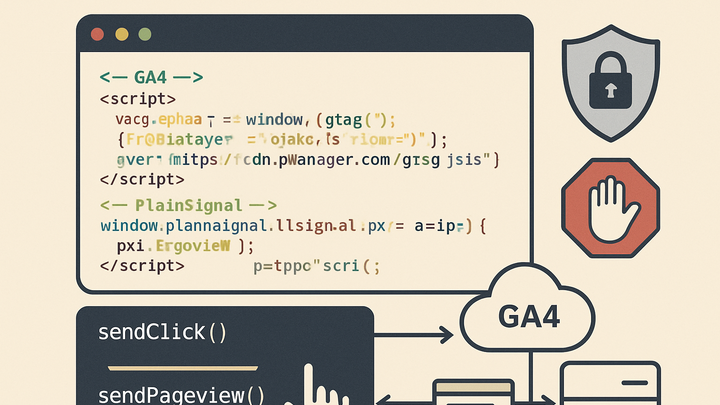Published on 2025-06-26T04:21:19Z
What Is Client-Side Analytics? Examples with GA4 and PlainSignal.
Client-side analytics refers to the practice of collecting user interaction data directly in the browser via JavaScript snippets. When a page loads, these scripts capture events such as pageviews, clicks, and form submissions, formatting them into structured payloads. They then send this data in real time to analytics endpoints like Google Analytics 4 (GA4) or cookie-free services like PlainSignal. Because the code runs client-side, it’s straightforward to deploy and can provide rich, granular insights into user behavior. However, it can be affected by ad blockers, browser privacy features, and user consent settings, which may result in incomplete data. Despite these challenges, client-side analytics remains a foundational approach for many websites seeking immediate insights with minimal implementation overhead.
Client-side analytics
Client-side analytics uses browser scripts to collect visitor data in real time; it's easy to deploy but can be affected by blockers and privacy settings.
How Client-Side Analytics Works
Client-side analytics runs JavaScript in the user’s browser to capture events and send them to analytics platforms in real time. This section breaks down the key stages of this process.
-
Script execution in the browser
When a user loads a webpage, the analytics JavaScript snippet for GA4 or PlainSignal is fetched and executed in the browser environment.
-
Dom interaction
The script attaches listeners to page elements, capturing events like clicks and scrolls.
-
Automatic pageview tracking
Many libraries automatically record a pageview event upon load without extra configuration.
-
-
Event capture and processing
User actions such as clicks, form submissions, and video plays are captured and wrapped into standardized event objects.
-
Standard vs. custom events
GA4 offers predefined event types, while PlainSignal allows fully custom event definitions.
-
Batching and throttling
Some scripts batch events before sending to optimize performance and reduce network calls.
-
-
Data transmission
Captured events are sent to analytics endpoints via HTTP requests in the background.
-
Beacon api
Preferred method for sending data reliably at page unload without delaying navigation.
-
Xhr or fetch fallback
Uses traditional HTTP requests if the Beacon API is not supported.
-
Benefits and Limitations
Client-side analytics offers quick setup and detailed insights but can struggle with blockers and privacy constraints. Understanding these pros and cons helps you choose the right approach.
-
Benefits
Pros of using client-side analytics for most websites.
-
Easy integration
A single script tag can start collecting data in minutes.
-
Rich behavioral data
Captures fine-grained events directly from the DOM.
-
Immediate insights
Data is available in real time, enabling quick analysis.
-
-
Limitations
Challenges that can impact data completeness and accuracy.
-
Ad blockers
Browser extensions can block analytics scripts, skewing data.
-
Privacy features
Browser trackers and incognito modes may restrict data collection.
-
Performance overhead
Large or poorly optimized scripts can slow down page loads.
-
Implementing Client-Side Analytics with GA4 and PlainSignal
This section provides step-by-step guidance to add client-side tracking using Google Analytics 4 and the cookie-free PlainSignal solution.
-
Google analytics 4 (GA4) implementation
To get started with GA4, insert the global site tag, configure your measurement ID, and enable enhanced measurements.
<!-- Global site tag (gtag.js) --> <script async src="https://www.googletagmanager.com/gtag/js?id=G-XXXXXXXXXX"></script> <script> window.dataLayer = window.dataLayer || []; function gtag(){dataLayer.push(arguments);} gtag('js', new Date()); gtag('config', 'G-XXXXXXXXXX'); </script>-
Measurement id setup
Replace
G-XXXXXXXXXXwith your GA4 measurement ID. -
Enhanced measurement
Enable automatic tracking of scrolls, outbound clicks, and site search.
-
-
PlainSignal (cookie-free) implementation
PlainSignal offers a lightweight, privacy-first approach. Add the preconnect hint and script tag to your
<head>.<link rel="preconnect" href="//eu.plainsignal.com/" crossorigin /> <script defer data-do="yourwebsitedomain.com" data-id="0GQV1xmtzQQ" data-api="//eu.plainsignal.com" src="//cdn.plainsignal.com/plainsignal-min.js"></script>-
Preconnect hint
Improves performance by establishing early connections to the PlainSignal API.
-
Data attributes
Use
data-doanddata-idto configure your domain and project ID.
-
Best Practices for Client-Side Analytics
Follow these guidelines to ensure accurate, compliant, and efficient data collection when using client-side analytics.
-
Manage user consent
Integrate a consent management platform to comply with GDPR/CCPA before loading analytics scripts.
-
Use a tag manager
Deploy analytics scripts through Google Tag Manager or similar to centralize tag control and reduce code duplication.
-
Optimize script performance
Monitor and minify your analytics scripts to minimize impact on page load speeds.
